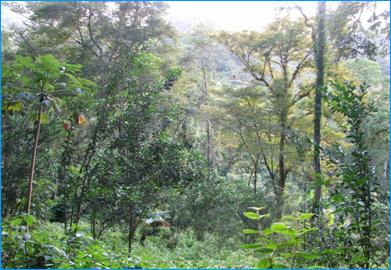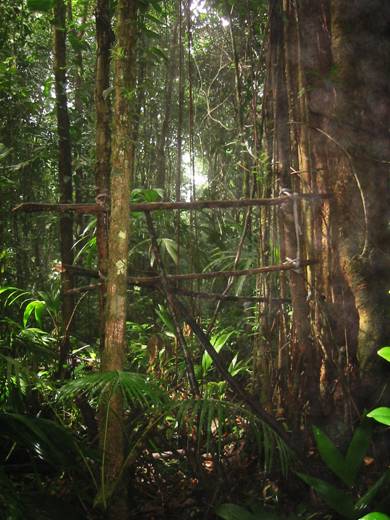

The Trinidad Piping-guan Pipile pipile, also known locally as the Pawi, is Trinidad’s only endemic bird. It is a large, glossy black, turkey-like bird with white wing coverts, a white crest, red legs and a blue cere and dewlap.

|
At present, four distinct vocalizations have been recorded for the Pawi. The one most frequently heard is its piping call from which the bird gets its formal name: the Trinidad Piping-guan. This call consists of four ascending whistles which are repeated at intervals. The other three, which are heard less often, are a single note whistle, a ‘pee-oo’ call and a quacking call. In addition to these vocalizations is the Pawi’s wing drumming, a sound made by the wings while in flight. As the sound is not always present during flight it is thought that the Pawi chooses to wing drum on particular occasions.
We do not yet understand the meaning of the different vocalizations or wing drumming but current research should lead to a better understanding of the role of these sounds in Pawi communication.
Pawi are found within about 150 km2 of forest in the eastern half of the Northern Range. They are seen both in deep forest and in disturbed edge habitat, sometimes even along roadways and near houses. They are arboreal birds spending the majority of their time in trees and seem to prefer the higher branches of tall trees, although they are sometimes seen in low trees such as cocoa and very rarely on the ground itself.
The birds eat a variety of leaves, vines, fruits and seeds from both native plants such as bois canot and cajuca as well as imported plants such as nutmeg and mango. They have been seen drinking water which collects in epiphytes and it is believed that they get most of their water from this source.
For the majority of the year Pawi are seen alone or in groups of two or three birds but in certain months they have been noted moving around in fixed pairs (the same individuals always being seen together), possibly a sign that they have paired for mating. Very little is known about their breeding biology, including their breeding and nesting season, structure of nests and appearance and number of eggs and chicks. It is hoped that with careful and persistent research these mysteries will be uncovered and enable us to better protect this critically endangered bird.

| 
|
It is said that in the early 20th century Pawi were common and were found throughout Trinidad’s forests from the mountain peaks down to sea level. Now the species appears to be restricted to a much narrower range. This drastic narrowing of the species' range seems to have been accompanied by a population decline as well. It is estimated that there are less than 200 individuals on the planet. The decrease in both range and population size is believed to be due mainly to habitat disturbance/destruction and illegal hunting.
Illegal huntingIt is believed, that in the past, hunting contributed greatly to the decline of the Pawi population. Their size and unruffled nature made them easy targets for hunters and many were thought to have been killed over the years reducing the population dramatically. Illegal hunting of Pawi still occurs today but has been made almost non-existent as a result of increased awareness and growing Pawi-focused ecotourism tours which make Pawi more valuable alive than dead.

|
Habitat disturbance and destruction is a less direct threat but is still of great concern. Logging, clearing of the forest vegetation and pollution all play a role in the disturbance and/or destruction of the Pawi’s forest habitat. These activities destroy areas that it may use for roosting, nesting and feeding. It may also be possible that chicks can be killed during vegetation clearing or slash and burn activities. To protect these birds we need to ensure that there is enough good forest for them to survive. The recent creation of the Matura National Park as an Environmentally Sensitive Area will go a long way in the protection of the Pawi’s natural habitat but we must also ensure that, as individuals, our activities in the forest do not promote destruction or disturbance of this bird’s habitat.
Fortunately, while these factors still threaten the species today, there seems to be a renewed interest in the protection of this bird and a change of attitude towards it by many of the communities within its range. The hard work of the Environmental Management Authority, Wildlife Division, the University of the West Indies, Asa Wright Nature Centre and the Pawi Study Group has helped to increase local communities’ understanding of the Pawi and nurture the use of it as an ecotoursim attraction. And of course, the community members with new knowledge and awareness of the Pawi have themselves become the main protectors of this amazing bird.
As an endemic bird species with an approximate population of less than 200 individuals (Birdlife International, 2000), faced with increased habitat degradation and the threat of hunting, the Trinidad Piping-guan is in danger of becoming extinct. As such it has been listed as Critically Endangered in the IUCN Red List and as an Immediate Conservation Priority in the IUCN Cracid Specialist Group Action Plan. In addition it has been designated locally as an Environmentally Sensitive Species by the Environmental Management Authority.
It is hoped that through increased understanding of the species and the combined effort of concerned individuals and organizations we can make a positive difference to the future of the Pawi.
Let us know if you see any Pawi, how many you see, where they were and what they were doing.
All sightings are potentially valuable in our research aimed at saving the Pawi.
Please report sightings online:
Online form
[Not functional at present due to demise of geocities.com]
About the Pawi : Contact us : How you can help : Projects and activities : PSG home page